 |
|
| Mountain Summer Resort |
| CCTV.COM 2002-09-03 14:09:05 |
|
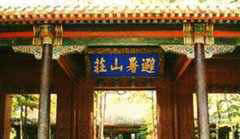 In early September 1703 when Emperor Kangxi finished his tour in North China and his hunting in the imperial preserves, he passed by Wulie River on his way home. Seeing the towering Panchui Peak in a delightful contrast with its surroundings, the emperor ordered to dig lakes, build dikes and gardens in this auspicious spot, where the summer was cool and winter was warm and there was a hot spring for bath. Thus appeared the Hot River Palaces and imperial gardens that condensed all beautiful scenic spots in north and south of China. This place is called the Mountain Summer Resort. In early September 1703 when Emperor Kangxi finished his tour in North China and his hunting in the imperial preserves, he passed by Wulie River on his way home. Seeing the towering Panchui Peak in a delightful contrast with its surroundings, the emperor ordered to dig lakes, build dikes and gardens in this auspicious spot, where the summer was cool and winter was warm and there was a hot spring for bath. Thus appeared the Hot River Palaces and imperial gardens that condensed all beautiful scenic spots in north and south of China. This place is called the Mountain Summer Resort.
The Mountain Summer Resort situates at present-day Chengde, Hebei Province. It has the palaces in its south and the gardens in the north. The palaces were for emperors to handle political affairs and to dwell; the gardens had lakes, hills and grassland. The buildings in the Resort with little ornaments were constructed in grey bricks and tiles and unpainted wood. The simple style emitted the charm of wild nature.
The main palaces in Mountain Summer Resort had nine courtyards of different sizes, with the offices in the front and dwelling quarters at the back, which had been an established institution for imperial constructions. The main hall, the Hall of Simplicity and Piety, was later refurbished with unpainted nanmu, hence the by-name Nanmu Hall. In wet days the hall gives out a faint smell of the wood nanmu.
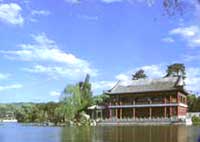 “The Hall of Simplicity and Piety is the place for important ceremonies in the Mountain Summer Resort. In early Qing Dynasty emperors received foreign envoys and chieftains of ethnic groups many times in this hall. The chieftain of Torgut tribe coming back from Volga and the Tibetan political and religious leader Bainqen VI were received by Emperor Qianlong here. The Mountain Summer Resort was not an imperial summer palace in its usual meaning, but virtually had become an important political centre next to Beijing,” said Wang Tianyou, professor at Beijing University. “The Hall of Simplicity and Piety is the place for important ceremonies in the Mountain Summer Resort. In early Qing Dynasty emperors received foreign envoys and chieftains of ethnic groups many times in this hall. The chieftain of Torgut tribe coming back from Volga and the Tibetan political and religious leader Bainqen VI were received by Emperor Qianlong here. The Mountain Summer Resort was not an imperial summer palace in its usual meaning, but virtually had become an important political centre next to Beijing,” said Wang Tianyou, professor at Beijing University.
The Mountain Summer Resort has eight large and small artificial lakes. Emperor Kangxi commented the Resort as "having the mountains as the bone and water as the heart". Emperor Qianlong's remark "Though it is named Mountain Resort, its beauty is in water" highlighted the feature of the resort. Because Emperors Kangxi and Qianlong many times toured in South China and they appreciated the beautiful gardens there, many scenic spots after famous gardens throughout the country were built around the lakes in the Resort. The Gold Hill Temple in Zhenjiang, the Tower of Mist and Rain at the South Lake in Jiaxing and likes were "moved" by the emperors into the resort. Those interesting buildings, however, were not exact copies.
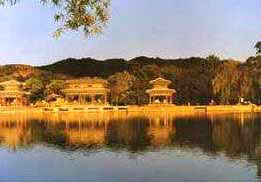 North to the lakes in the Resort was a stretch of forest and grassland. It is said many elks, cranes and tribute horses from different places were kept there. Emperor Qianlong named this place "Garden of Ten Thousand Trees". In the north of this place there were once 28 yurts, in which important political activities took place. When Emperor Qianlong was in reign, he received chieftains of the Dorbot and Torgut Mongolian tribes and treated them with banquets there. It was also in one of these yurts that the British envoy George Macart'ney submitted a credential. North to the lakes in the Resort was a stretch of forest and grassland. It is said many elks, cranes and tribute horses from different places were kept there. Emperor Qianlong named this place "Garden of Ten Thousand Trees". In the north of this place there were once 28 yurts, in which important political activities took place. When Emperor Qianlong was in reign, he received chieftains of the Dorbot and Torgut Mongolian tribes and treated them with banquets there. It was also in one of these yurts that the British envoy George Macart'ney submitted a credential.
The Mountain Summer Resort has left its deep trace in Chinese history.
To appease the Mongolians and other ethnic groups in western border regions, the rulers of China's last feudal dynasty Qing had a series of imperial temples built around the Mountain Summer Resort in Chengde. From 1713 to 1784, twelve temples were built. These grandiose and splendid imperial temples are called the "outer temples" in Qing-dynasty official literature. Along with the temples emerged a holly place of Tibetan Buddhism to the wild north of the Great Wall.
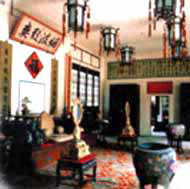 “When the Qing government made Beijing its capital, it paid attention to the relationship with the national minorities in Mongolia, Xinjiang and Tibet. Take Mongolia for example, the Qing rulers kept a marriage relation with Mongolian nobles. While boosting the status of the Mongolians, the government strengthened administrative measures in Mongolian region. During the reign of Qianlong, this state policy was further put into effect. This is seen in the temples around the Resort. It may be put this way, that the temples around the Mountain Summer Resort were the outcome of the policy of national solidarity and consolidation of the multi-national country employed by Emperors Kangxi and Qianlong,” said Wang Tianyou. “When the Qing government made Beijing its capital, it paid attention to the relationship with the national minorities in Mongolia, Xinjiang and Tibet. Take Mongolia for example, the Qing rulers kept a marriage relation with Mongolian nobles. While boosting the status of the Mongolians, the government strengthened administrative measures in Mongolian region. During the reign of Qianlong, this state policy was further put into effect. This is seen in the temples around the Resort. It may be put this way, that the temples around the Mountain Summer Resort were the outcome of the policy of national solidarity and consolidation of the multi-national country employed by Emperors Kangxi and Qianlong,” said Wang Tianyou.
Most temples there bore earmarks of Tibetan temples. The Temple of Universal Peace was an architecture that had both Tibetan and Han characteristics. Its hind part was mainly Tibetan flat-topped constructions. They were in wooden structures with Han-style roofs, accompanied by the Lama stupas in stones and bricks in different forms. At the centre of the Chamber of Mahayana was the 22-metre statue of the thousand-hand and thousand-eye Avalokitesvara. For this the Temple is also called the "Temple of Great Buddha."
The Sumeru Temple of Fortune and Longevity alias Auxiliary Palace was built in 1780. The sixth Bainqen made a 10,000-km arduous journey in one year from the Tashilhunpo Temple in Xigaze, Tibet to the Mountain Summer Resort in Chengde to celebrate the 75th birthday of Emperor Qianlong. Then the Qing court had just defined the Rules on Reconstruction of Tibet and employed a series of reform measures. To "win over the people of a region by one man's audience in court", Emperor Qianlong decided to build this temple after the Tashilhunpo in Tibet and held a grand welcome ceremony on Bainqen's arrival. This reflected the close tie between the local authorities of Tibet and the Qing government.
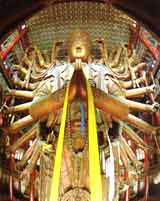 The Temple of Putuo is the largest one in the "outer temples". Putuo is Chinese transliteration of Sanskrit "Potala", which is the place of Avalokitesvara. The Temple of Putuo was built in imitation of Potala in Lhasa, hence the nick-name "Little Potala". The Temple has a red terrace and a white terrace. The main part of the temple, the red terrace, is in a Tibetan form of double square loops. In the Hall of Unification of All Dharmas lies a treasure bed, which was for the Tibetan political and religious leader Dalai Lama. The Temple of Putuo is the largest one in the "outer temples". Putuo is Chinese transliteration of Sanskrit "Potala", which is the place of Avalokitesvara. The Temple of Putuo was built in imitation of Potala in Lhasa, hence the nick-name "Little Potala". The Temple has a red terrace and a white terrace. The main part of the temple, the red terrace, is in a Tibetan form of double square loops. In the Hall of Unification of All Dharmas lies a treasure bed, which was for the Tibetan political and religious leader Dalai Lama.
The Mountain Summer Resort and the Eight Outer Temples add radiance to each other among grandiose mountains and rivers. They are telling an eternal history.
|
|
Editor: Liu Baoyin CCTV.com
|
|
|
|
|
|
 |









